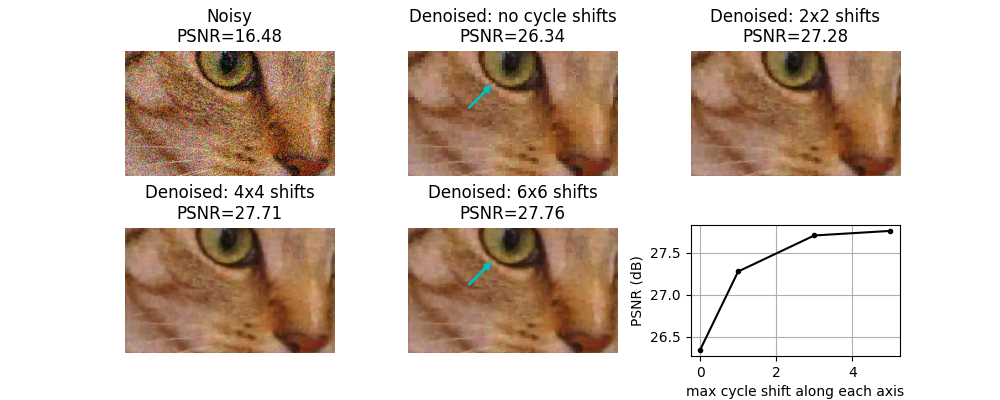注意
转到结尾下载完整的示例代码。或通过 Binder 在浏览器中运行此示例
平移不变小波去噪#
离散小波变换不是平移不变的。平移不变性可以通过非抽取小波变换(也称为静止小波变换)来实现,但代价是增加了冗余(即小波系数比输入图像像素多)。在离散小波变换的图像去噪中使用“循环旋转”技术是另一种近似平移不变性的方法。这涉及到对多个空间位移 n 执行以下 3 步过程的结果求平均值
将信号(循环)移动一定量 n
应用去噪
应用反向移动
对于 2D 图像去噪,我们在此处演示了这种循环旋转可以显著提高质量,大部分增益仅仅通过在每个轴上平均 n=0 和 n=1 的位移来实现。

Clipping input data to the valid range for imshow with RGB data ([0..1] for floats or [0..255] for integers). Got range [-0.020569158406717254..0.8458827689308539].
import matplotlib.pyplot as plt
from skimage.restoration import denoise_wavelet, cycle_spin
from skimage import data, img_as_float
from skimage.util import random_noise
from skimage.metrics import peak_signal_noise_ratio
original = img_as_float(data.chelsea()[100:250, 50:300])
sigma = 0.155
noisy = random_noise(original, var=sigma**2)
fig, ax = plt.subplots(nrows=2, ncols=3, figsize=(10, 4), sharex=False, sharey=False)
ax = ax.ravel()
psnr_noisy = peak_signal_noise_ratio(original, noisy)
ax[0].imshow(noisy)
ax[0].axis('off')
ax[0].set_title(f'Noisy\nPSNR={psnr_noisy:0.4g}')
# Repeat denosing with different amounts of cycle spinning. e.g.
# max_shift = 0 -> no cycle spinning
# max_shift = 1 -> shifts of (0, 1) along each axis
# max_shift = 3 -> shifts of (0, 1, 2, 3) along each axis
# etc...
denoise_kwargs = dict(
channel_axis=-1, convert2ycbcr=True, wavelet='db1', rescale_sigma=True
)
all_psnr = []
max_shifts = [0, 1, 3, 5]
for n, s in enumerate(max_shifts):
im_bayescs = cycle_spin(
noisy,
func=denoise_wavelet,
max_shifts=s,
func_kw=denoise_kwargs,
channel_axis=-1,
)
ax[n + 1].imshow(im_bayescs)
ax[n + 1].axis('off')
psnr = peak_signal_noise_ratio(original, im_bayescs)
if s == 0:
ax[n + 1].set_title(f'Denoised: no cycle shifts\nPSNR={psnr:0.4g}')
else:
ax[n + 1].set_title(f'Denoised: {s+1}x{s+1} shifts\nPSNR={psnr:0.4g}')
all_psnr.append(psnr)
# plot PSNR as a function of the degree of cycle shifting
ax[5].plot(max_shifts, all_psnr, 'k.-')
ax[5].set_ylabel('PSNR (dB)')
ax[5].set_xlabel('max cycle shift along each axis')
ax[5].grid(True)
plt.subplots_adjust(wspace=0.35, hspace=0.35)
# Annotate with a cyan arrow on the 6x6 case vs. no cycle shift case to
# illustrate a region with reduced block-like artifact with cycle shifting
arrowprops = dict(
arrowstyle="simple,tail_width=0.1,head_width=0.5", connectionstyle="arc3", color='c'
)
for i in [1, 4]:
ax[i].annotate(
"",
xy=(101, 39),
xycoords='data',
xytext=(70, 70),
textcoords='data',
arrowprops=arrowprops,
)
plt.show()
脚本的总运行时间:(0 分钟 1.410 秒)
